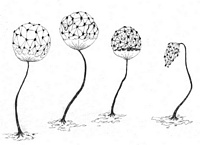|
 Cribraria aurantiaca Cribraria aurantiaca
SynonymsCribraria vulgaris var. aurantiaca
BiostatusPresent in region - Indigenous. Non endemic
Images (click to enlarge)
Caption: Sporangia of Cribraria aurantiaca. The two on the left are approximately 1.5
mm tall.
Owner: S.L. Stephenson |
Article: Stephenson, S.L. (2003). Myxomycetes of New Zealand. Fungi of New Zealand. Ngā Harore o Aotearoa 3: xiv + 238 p. Hong Kong: Fungal Diversity Press.
Description: Fruiting body a stalked sporangium, gregarious, 1–2 mm tall. Sporotheca globose, erect or nodding, at first bright yellow orrange but soon changing to ochraceous brown, 0.3–0.6 mm in diameter. Stalk subulate, dark, 2–4 times the height of the sporotheca. Hypothallus inconspicuous. Peridial net regular, with small meshes and few free ends, nodes numerous, small, round, convex, dark. Calyculus usually well- developed, occupying one-fourth to one-third of the lower portion of the sporotheca or occasionally less, the margin even, bearing numerous elongated teeth with a few spines or angles that bear the peridial net; dictydine granules moderately dark, 1–1.5 µm in diameter. Spores in mass yellow when fresh but fading to ochraceous-brown or brown, almost colourless in transmitted light but with one or sometimes more bright yellow inclusions present, nearly smooth, reniform when dry, 6–7 µm in diameter. Plasmodium bright green.
Habitat: Dead wood
Distribution: Widely distributed in temperate regions of the Northern Hemisphere (Martin & Alexopoulos 1969) and also known from South America (Farr 1976) and Africa (Ukkola 1998). First reported from New Zealand by Lister & Lister (1905), based on a specimen from Stewart Island. Also known from Southland (Rawson 1937).
Notes: The spores of Cribraria aurantiaca are distinctive in that they are reniform when dry and, in relatively fresh material, possess one to several conspicuous bright yellow inclusions when fully expanded in a wet mount on a slide.
|